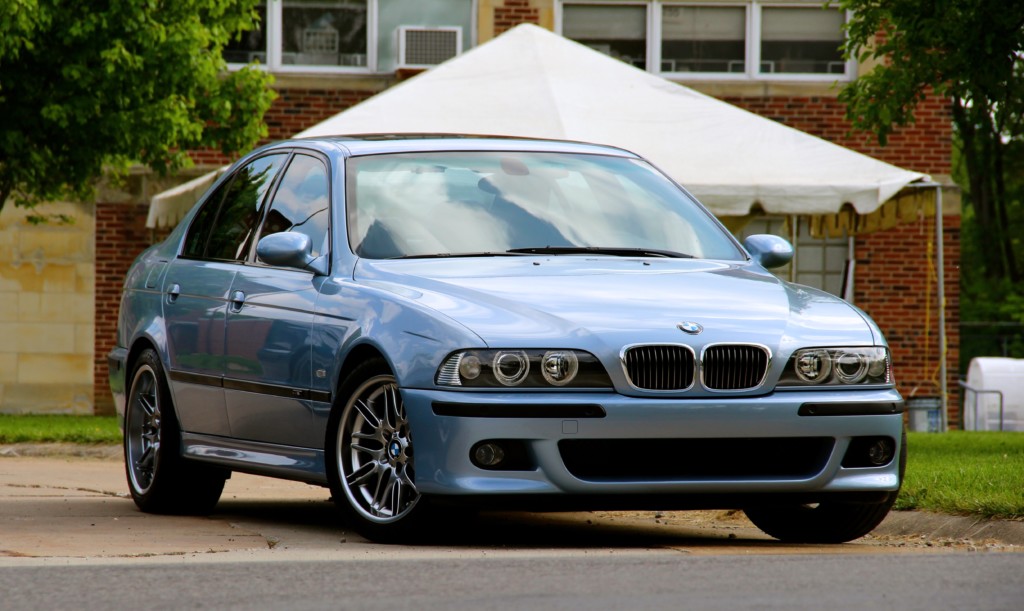
I bought my 2000 BMW M5 in 2010; it was my first car and I was 17 years old. Somehow, I didn’t kill myself. By 2011, the void of E39 M5 DIY content online made me think ‘If I want to see this content, maybe others would too.’ I decided to spearhead the lack of online content with E39Source. This has allowed me to connect with thousands of fellow E39 (M5) owners. Now after 12+ years of E39 M5 experience, I have come to know this platform quite well. For the first 8 years, I serviced my own vehicle. Since 2018, I have been offering my speciality E39 M5 services professionally at our shop located in San Diego, California. Each M5 owner has his or her own expectations for their car. Some are after pure performance, while others are allured by the M5’s unbelievable ability to be a refined luxury car one moment, and an involving analog sports car the next. I would never say that I have seen it all, but I have been exposed to a lot of very tasteful (and horrendous) modifications. In this article, in no particular order, I will list and describe several ‘must-have’ modifications, per my taste.
Maintenance
Before we get into the goodies, your M5 should absolutely be a mechanically sound vehicle. There is no sense in installing an expensive exhaust system on a car that needs tires, brakes, or control arms. I recommend starting with an inspection. E39Source offers a very comprehensive 100+ point inspection. We spend 3-4 hours combing over every detail of your 5-series, from the floor mats to the engine air filters; the stored DME codes to the gas cap tether. We then generate a report of our findings, tiered in 3 categories based on importance. We have completed hundreds of these inspections, and each and every E39 has different needs. I have performed the inspection on 20,000 mile cars in addition to 250,000 mile cars. Low mileage vehicles often require as much or more attention as their higher-mileage counterparts. Like most mechanical things, BMWs do not like to sit around for extended periods of time. As a rule of thumb, most wearable components will need to be replaced every 100,000 miles or so.
Genuine, OEM / OES, or Aftermarket Parts?
Your worn parts should be replaced with OE (original equipment) quality or better parts. Many people do not understand the difference between OEM/OES and Genuine parts. BMW themselves do not manufacturer things like control arms, brake pads and rotors, filters, or most electronic sensors. Instead, these items are farmed out to any number of OEMs (original equipment manufacturers.) For an example, the oil filter you buy for your M5 at the dealership comes in a box proudly labeled as “Genuine BMW”. The product inside the box was manufactured by perhaps Mann or Mahle, not by BMW. BMW buys these filters from their OEMs, puts a blue and white roundel sticker on it, and triples the price. You can source the same parts that came on your BMW from factory for a significantly more affordable cost- if you know how to correctly identify the OEMs. I have found that nearly all aftermarket parts are either horrible quality, lack important design features/functions, or are simply so poorly made that they don’t fit or work as designed.
Start with General Maintenance
On a newly acquired vehicle, a good place to start is often with some (likely deferred) general maintenance. We’re talking about engine filters, cabin filters, fuel filter, spark plugs, MAFs, cam sensors, batteries, brake pads and rotors, tires, and any worn suspension bushings, arms, struts, or links. Always follow up suspension service with a quality 4-wheel alignment. If your Service Engine Soon light is on, figure out why. Repair as required. I also recommend a fresh round of fluid changes (engine oil, differential fluid, transmission fluid, coolant, power-steering fluid, brake fluid, and blinker fluid). Now that you have a mechanically solid car, you can start toying with the extras.
Exhaust:
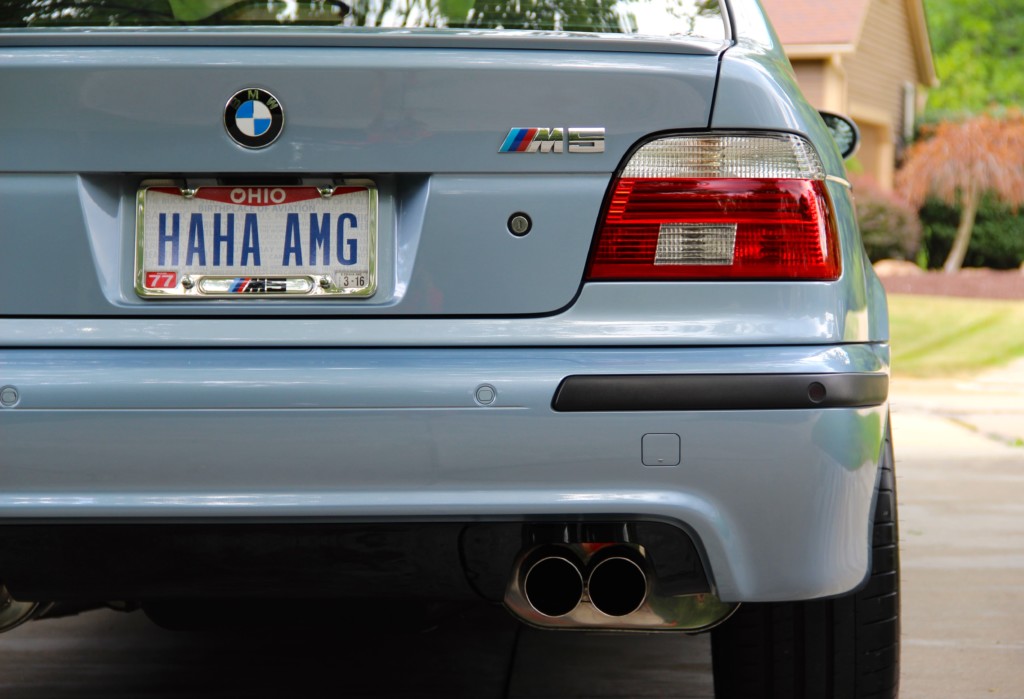
Eisenmann Race 4x76mm mufflers.
The stock E39 M5 exhaust system is very conservative- and many times, that’s good. Anybody that knows anything about cars can tell as soon as it fires up that it’s a big engine in there. But unless you’re daily-driving your grandmother to the bingo hall, you probably want to enjoy that S62 sound a bit more. I spent years researching and considering different exhaust options, of which there seem to be hundreds of. For me, it came down to these options: Eisenmann, Dinan, Supersprint, Hayward & Scott, Corsa, Tubi, Meisterschaft, Borla, Brittleman, Kelleners, Rogue Engineering, or simply (and cheaply,) a muffler delete. I’ll discuss a little about each option:
Eisenmann:
Pros:
Still manufactured
OEM style exhaust tips
Exhaust tip size options (76mm, 83mm, with 63.5mm being stock)
Race and Sport sound levels
Awesomely-exotic, higher-pitched V8 sound
Cons:
Expensive ($2,500 or so)
Anything except 83mm Race versions will take 8 weeks to produce and ship
Dinan:
Pros:
Still manufactured
OEM style exhaust tips
Boomy low end exhaust sound (sub 2k rpm)
Semi-affordable ($1,600)
Cons:
Very little difference in higher-RPM sound compared to stock
Significant rasp when paired with x-pipes or aftermarket cats/headers
Tubi (Rumore), Kelleners, Brittleman:
Pros:
- Absolutely amazing sound
Cons:
- No longer available. ANYWHERE. New or used. Don’t bother trying, I did for years.
Hayward & Scott:
Pros:
OEM style exhaust tips
Minimally invasive mufflers (don’t take up much space or hang down too low)
Cons:
Glorified muffler delete option
Expensive
Borla, Corsa, Meisterschaft, SuperSprint, Rogue:
Pros:
Still manufactured
Cons:
Aftermarket looking tips
Mixed reviews of product and sound quality
Muffler Delete
Pros:
Cheapest option by far, $300-$500
Loud- is that a pro for you? It is not for me.
Cons:
Rough and raspy sound
Not an actual product
Loud, very loud
Sloppy
I made the decision to go with Eisenmann Race, the 4x76mm tip version. I absolutely LOVE the sound that it makes. It’s a very exotic, higher pitched growl. I have kept the stock headers and cats in place. The Eisenmann mufflers offer an enhanced visual appeal as well, slightly modernizing the car with the larger tips. You can elect to upgrade your headers, cats, or resonator (to an x-pipe) if you like, but this can vastly increase the volume of your exhaust. The stock resonator will prevent excessive drone with a muffler delete, and with any real system, it makes the car behave quite responsibly. About a year after going with Eisenmann Race mufflers, I found myself wanting more. The Rogue Diablo resonated x-pipe was my ultimate answer. There are 3 solid resonators available: Rogue Diablo, Superesprint, and Jed’s X-pipe. The Rogue Diablo is a resonated x-pipe (two 10″ resonators) that allows the volume of the existing exhaust to increase by ~25%. It’s the perfect setup for my M5 and my tastes.
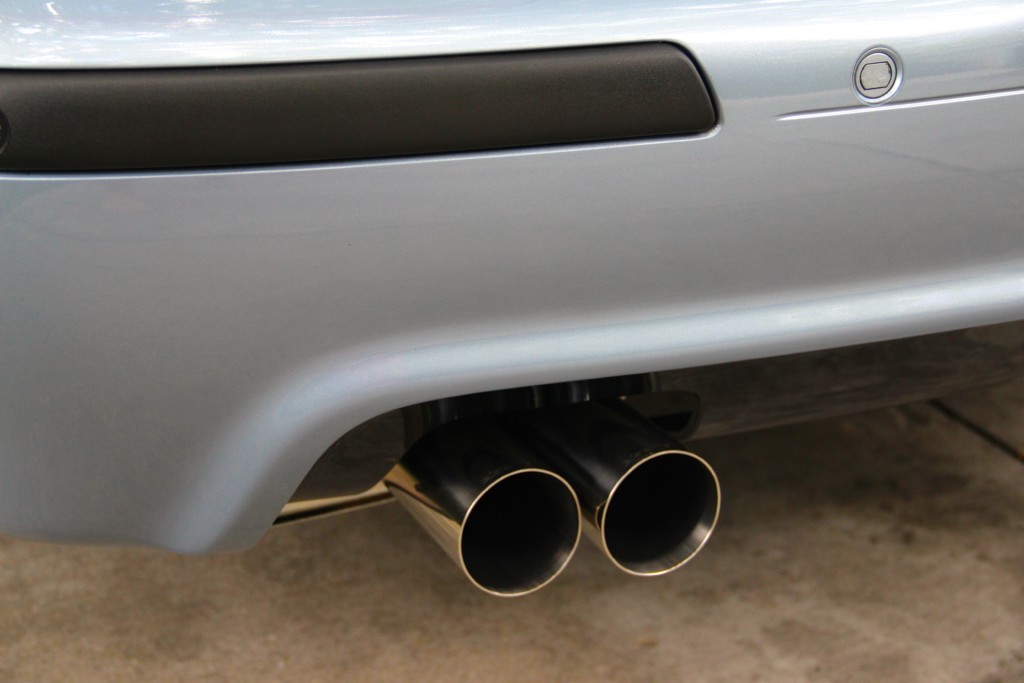
Eisenmann Race 4x76mm mufflers.
Headers
If you’re after power, upgrading your headers is a must. The E39 M5’s exhaust manifold design was borrowed straight from the E39 540i’s M62 V8. The only change they made was removing the cats from the headers. The M62’s manifolds came largely untouched from the M60 V8. The M60 V8 was used in the early E38 740is, the E34 540i, the E31 840i, and the E32 740i. We’re talking about cars designed and sold in the late 80s and early 90s. BMW allegedly intended to engineer custom S62 M5 headers, but ran out of time. Since 1999, there are several options for aftermarket headers that can unlock as much as 50 horsepower (with a tune). If you find Dinan headers, buy them. Jed’s Unicorn equal-length headers are probably the best in today’s marketplace, though you’ll need to be prepared to spend over $5,000 for the product alone. I have not experienced these for myself yet, but Jed claims they don’t have a large effect on the sound- which to me would be a huge plus. I have driven M5s with Supersprint and Evolve headers, and I truly hate the sound. They make the M5 sound more like a 1970s muscle car than a German sports sedan. While the American muscle car sound is great, I don’t want it in my BMW. Installation and fitment is also nightmare. On my own car, I’ve never had the desire to change the headers. Even though they may not be the most efficient, the factory exhaust manifolds do the job just fine.
Short Shifter
The stock E39 M5 shifter is not bad- when it’s in good shape. Too many people have neglected the shifter carrier bushings, which leads to a ton of play in the shifter, and subsequently very sloppy shifting. There are many options for upgrading the shifter: UUC, Rogue, Dinan, Hurst, or the E60’s 545i shifter. I had the UUC EVO 3 shift kit with the DSSR in my M5 for over a year. It was not nearly as precise or high-quality as the folks at UUC will lead you to believe. I then went to the much cheaper E60 545i shifter, still paired to UUC’s DSSR. This setup is second to none in my opinion, I really couldn’t be happier. It delivers short, crisp shifts that are still as predictable and easy to find as the OEM setup. The shifter is also about an inch lower to the center console, which I personally find more ergonomic and visually appealing.
Pro tip: Change your transmission fluid during the shifter install. This will lead to smoother shifts, and will lengthen the life of your transmission. Always be sure to replace your shifter carrier bushings (2 front, 1 rear), the clip, the shifter cup socket, and the rod joint that attaches to the transmission’s selector shaft when changing the shift lever.
Software Tune
The E39 M5’s stock MSS52 computer’s tune is quite good. The throttle, while in Sport mode, is perhaps the most precise and accurate throttle I have ever felt in a vehicle. Each mm of pedal travel translates to an instantaneous response from the engine. But there is a way to further enhance this precision, and perhaps gain a few horsepower in the process. Dinan makes several tunes, and so does Evolve, but I went with Turner Motorsport’s Jim Conforti designed Shark tune. You get some options from the Shark, such as what grade fuel you plan to run, which redline you’d like, and most attractive to you 2000 M5 owner’s: an SAI delete option. The SAI delete option bypasses the “Secondary Air – Flow too Low” 170 or AA code that triggers the service engine soon lamp (and causes a California SMOG test failure). Without sacrificing anything, you can simply program your car to ignore that code and no longer report the trouble code. While I have found the Shark tune to make the throttle noticeably sharper, I can’t say that I have felt a ton of additional power, though Turner does state gains of 23hp and 19lb/ft, at 6,100 and 5,000rpm respectively. I won’t deny their claims, but don’t install this tune purely as a power modification. It’s a ~$350 DIY affair to flash the ECU with this software, and realize immediate gains.
Pedal Kit
This is a small one, but you can add a solid visual and tactile feel improvement to the driving experience of your M5 by installing a simple pedal cover kit. Dinan, BMW, Bimmian, and countless Ebay vendors sell E39 M5 pedal kits. I first tried the OEM BMW pedals, which ended up going back to the dealer. The listed Genuine BMW part number for the aluminum performance pedal kit is 35002213213. This kit fits all E39 models except the M5. The sport pedals don’t fit their sportiest model! As it turns out, the M5 got a different throttle pedal, which is taller than the standard E39’s accelerator pedal. I wasn’t a big fan of the Dinan or the Ebay pedals, so I ended up buying Bimmian’s PED39MNOY “OEM-style” aluminum pedals with rubber inserts. I made an installation DIY video on E39Source which is embedded below. They took a few hours to install and cost me just over $100. Unfortunately, Bimmian is no longer in business, and their pedals are nowhere to be seen. In this market, I do not know what the best answer is.
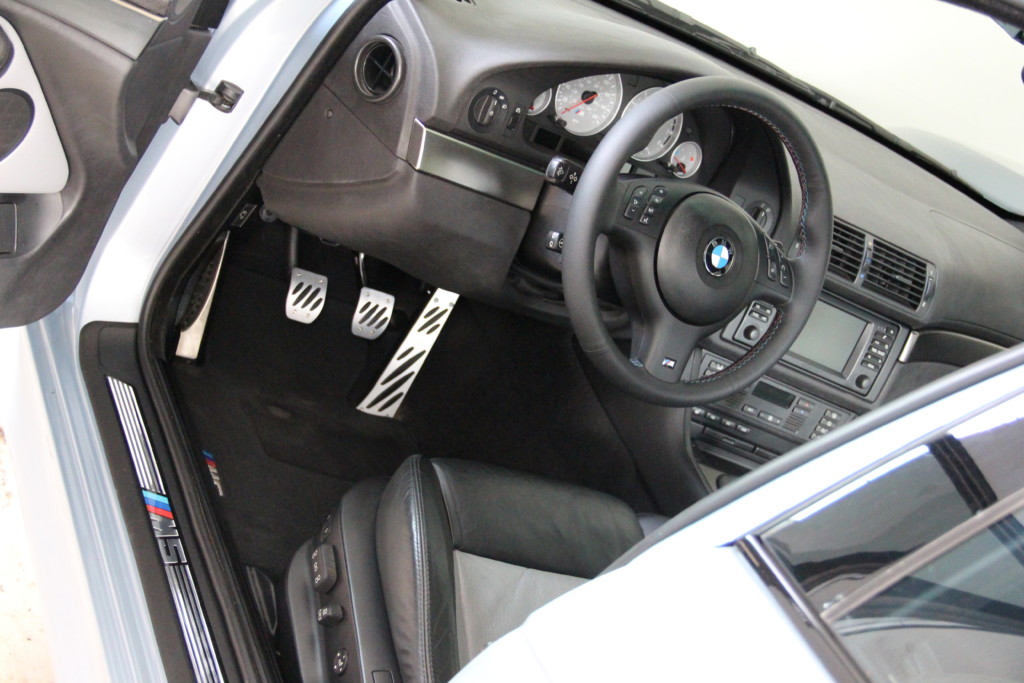
Bimmian sport pedals installed.
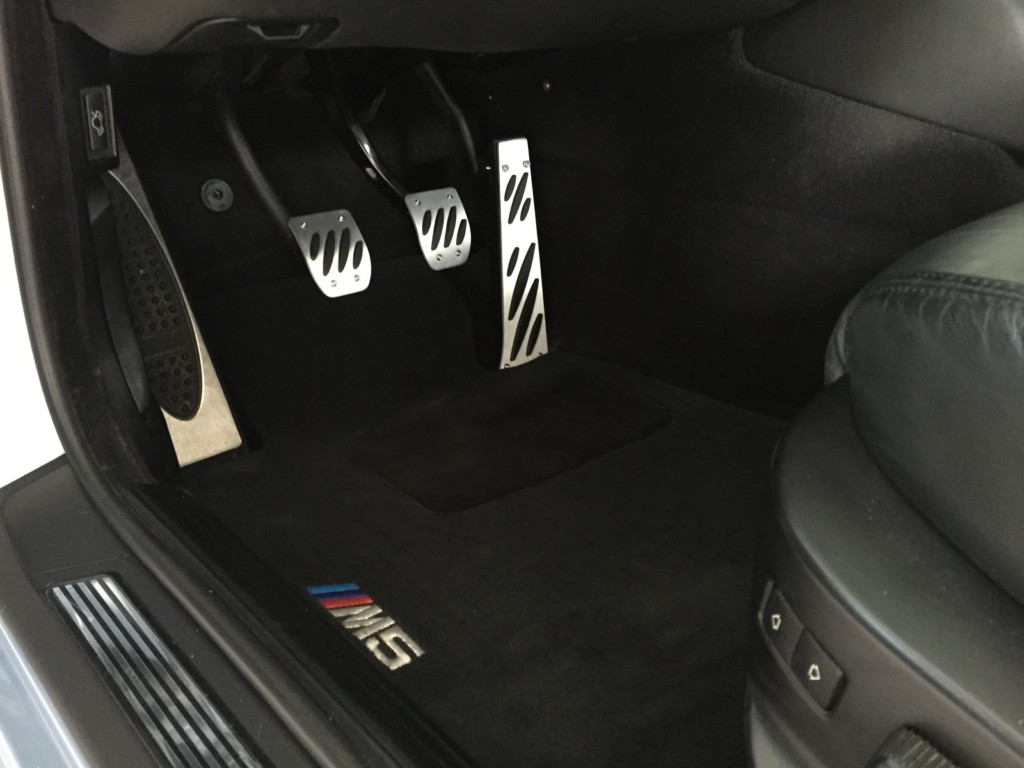
Bimmian sport pedals installed.
Radio / Aux / Navigation Tech
I am going to completely re-write this segment. The original text, which I still employ most of in addition to this product, is italicized below. A product released in 2020 totally changes the game for the E39: BlueBus. I worked with Ted, the founder and developer of BlueBus, to help beta test different hardware/software versions for months leading up to the initial launch. The BlueBus is a small device that is easily installed in the trunk of your E39. All you have to have is CD-changer pre-wiring. You don’t need DSP, high-OBC, navigation, an updated radio, an updated anything. This thing is completely plug-and-play. BlueBus gives you bluetooth connectivity for seamlessly streaming audio and phone calls, and even has it’s own UI that will display either on your navigation display or MID, whichever your BMW has. It also includes some neat tricks and enhancements for the car. My favorite: comfort turn signals. When switching lanes in newer cars, you can just tap the signal stalk and it will blink 3-5 times so you don’t have to hold the stalk. The E39 now has this feature, configurable between 1-8 automatic clicks. It can also be configured to automatically lock the car as you start driving, and then un-lock the car as you shut off the engine. Another recent addition is the ability to use the halo rings as daytime running lights. Even more features are coming soon in software updates. Please see the demo video below, and read more at the official website here. If there is one product you decide to try from this post, it needs to be this one. I am not even paid to say this.
BlueBus Installation, Demo, Review
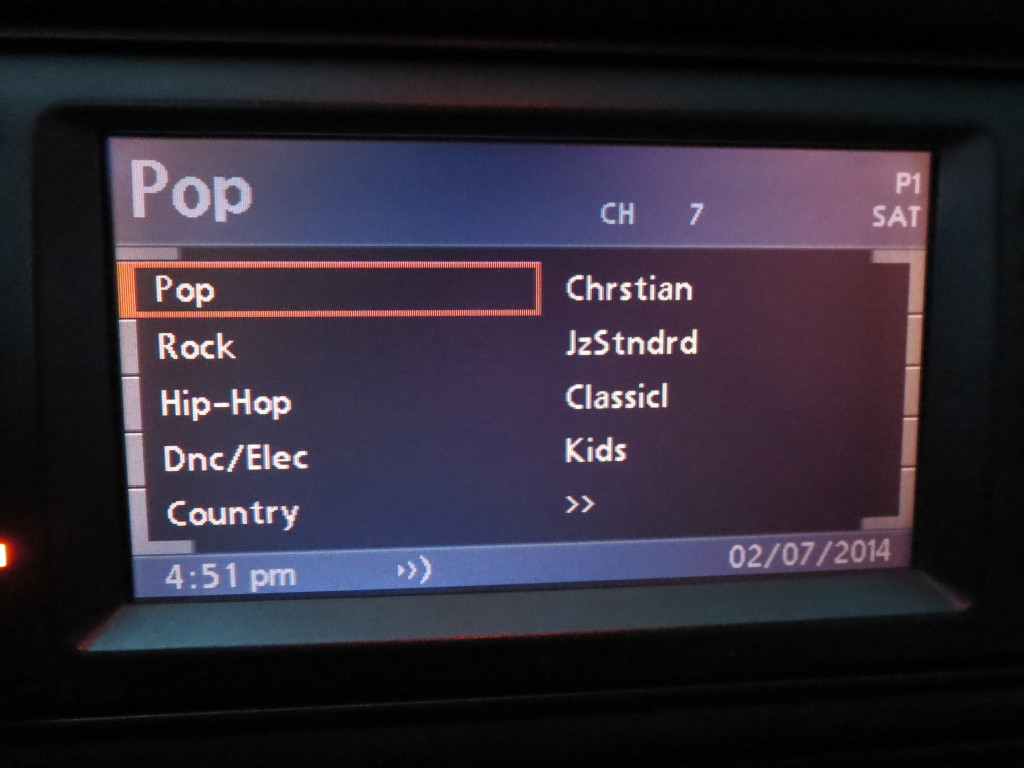
Sirius XM input.
This one can get really expensive. The neat thing about the E39 is that it can be brought right up to 2017 with it’s technological capabilities. When it was released in 2000, an auxiliary input, bluetooth, and Sirius XM were not even imagined yet. Luckily for us, the E39’s tech interface was in service through 2010 in the E83 X3 chassis, so it received the necessary upgrades and support to retrofit OEM aux, Sirius XM, and DVD-based navigation (MKIV computer). Even though never fitted to the E39, Genuine BMW Sirius XM and auxiliary input kits can be retrofitted to any E39 M5. I wrote a very detailed, in-depth article about all of this, which I encourage those of you who are interested to read here. You can also update the navigation equipment (if necessary) to the 16:9 widescreen display, faster, DVD-based MKIV computer, and 2015 map DVD with POIs. Please read about that here. This upgrade makes the E39 M5 so much more usable and enjoyable as a daily driver. I get in my car, turn the key, and my iPhone automatically connects via bluetooth to the factory stereo and starts playing right where it left off.
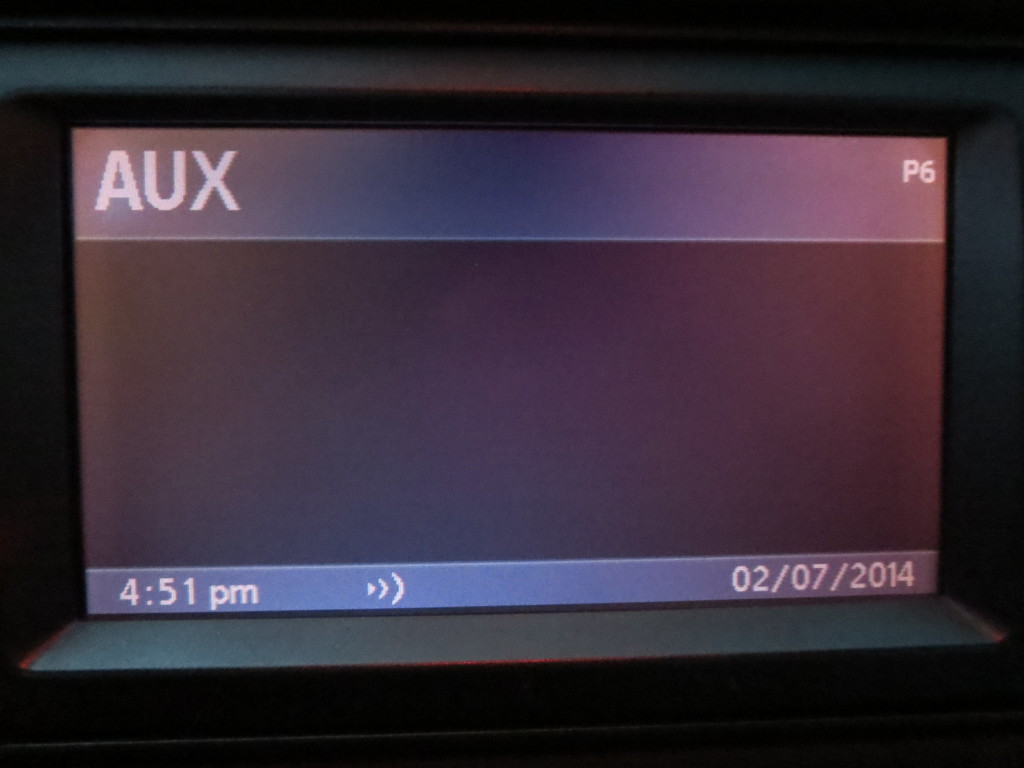
Aux input.
MKIV and 16:9 Display Installation
Sirius XM, Aux Input, BM53 Installation
Radar Detector
Do yourself a favor, get a radar detector. I ran without one for a few years, but picked up several tickets. Not even big tickets, I actually got a ticket (and two points on my license) for doing 39mph in a 35mph zone. I did my research, and decided that the Valentine One detector would be the best detector for me. I have since upgraded the newer Gen2 version. As Alex Roy said, a tool is only as good as the user’s knowledge of it. The Valentine One is very easy to get acquainted with. If you determine that an Escort, Beltronics, or Passport product better fits your needs, then by all means, buy one of those. Please do a hardwired install though, keep our interior clean. I have embedded the V1 hardwire install DIY below for your convenience.
M-Audio, Bavsound
For 2001, BMW offered an M-Audio package as a cost upgrade on the M5. M-Audio uses the same amp as the base M5’s DSP system, but replaces all of the door and rear parcel shelf speakers with higher-fidelity units that have kevlar cones instead of paper. More importantly, the M-Audio package replaces the rear subwoofers. The standard E39 M5 audio system (DSP) made use of two small Nokia subwoofers in a carpeted box on the ceiling of the trunk. The M-Audio system setup got two 10-inch subs mounted in the same location. Unsurprisingly, these 10-inch subs pack a lot more punch than the smaller Nokia ones. The install process is not too difficult, and not all that expensive if you can source a used set of M-subs, with a wiring lead. Changing the door speakers to the higher-quality M-Audio variants is not plug and play, seeing as the wiring harness in the doors changed. So let this mod just include the M-sub retrofit. In 2022, I ended up upgrading my door (and rear parcel shelf) speakers to Bavsound. The Bavsound speakers are a minor upgrade, but I elected to go this route to simply refresh my speakers after 22 years of service. They do sound a bit better, and can go louder before distorting compared to the standard DSP speakers. This upgrade is not required (or actually possible) with factory M-audio speakers.
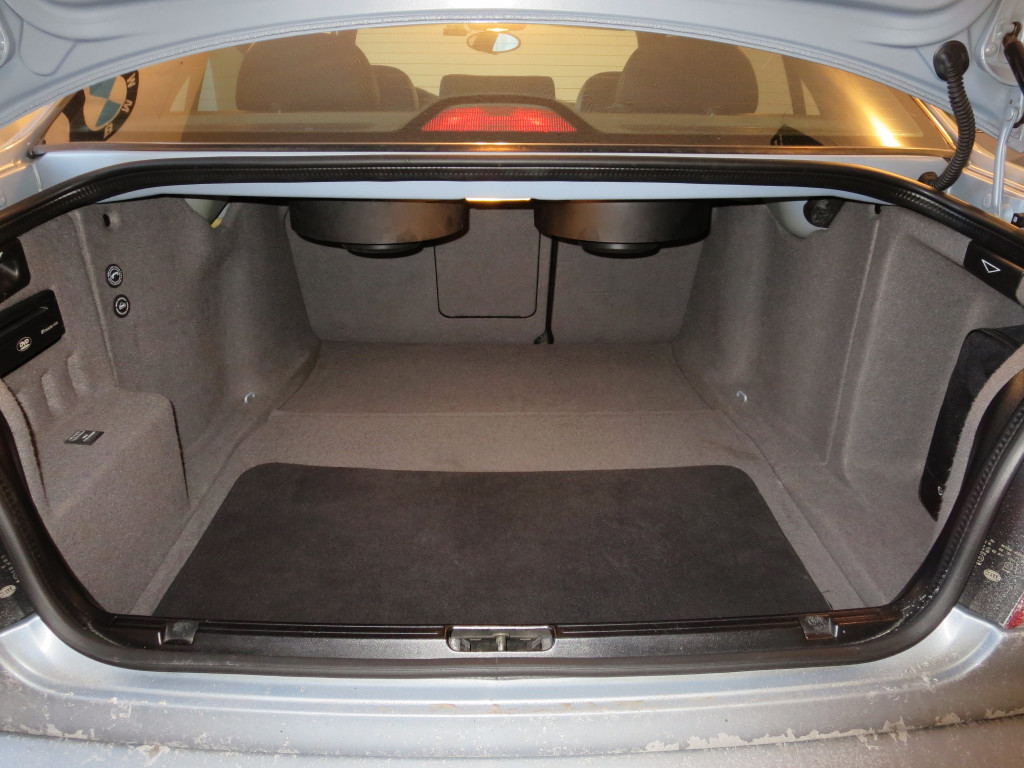
Two 10″ M-Audio subwoofers installed.
M-Audio Subwoofer Installation
Tires
I cannot overstate the importance of quality tires (and frequent alignments). I have run Michelin Pilot Sport All-Season 2s, 3s, Pilot Super Sports, and now Pilot Sport 4S’ on my M5. All of these tires are quality, safe performance tires. You get what you pay for when it comes to tires. I would never advise putting cheap tires on your car; they are the first and arguably most important thing between you and the road. If you’re coming from worn tires, cheap tires, or both, a fresh set of Michelins will transform how your car rides, drives, and protects you on the road.
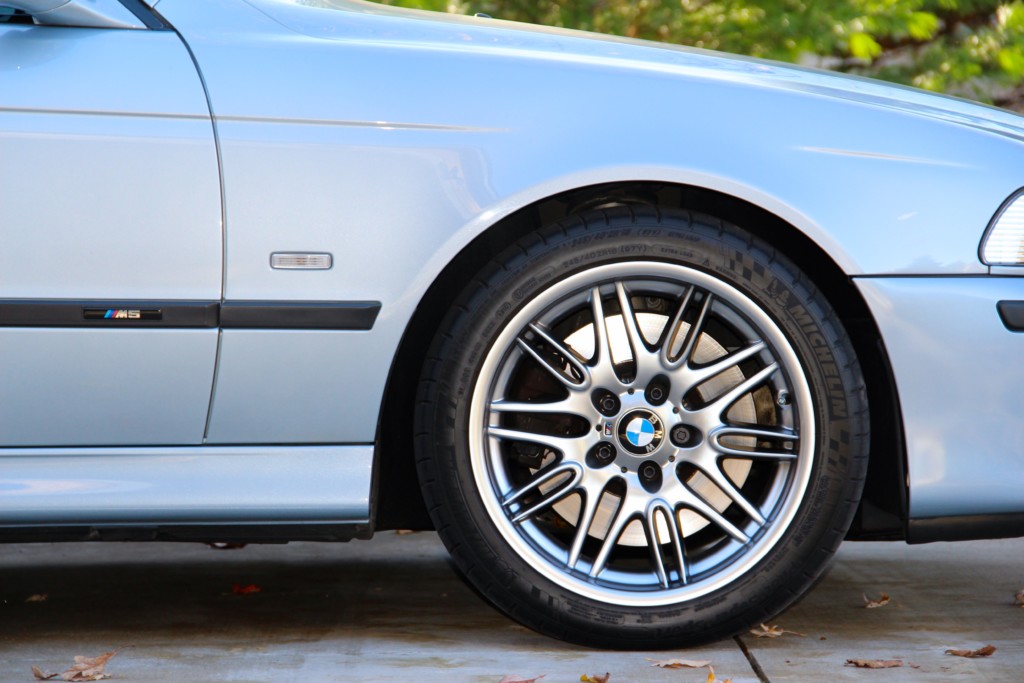
Facelift
I have written many in-depth articles specifically about what BMW changed on the E39 throughout production, and how to retrofit facelift parts to your pre-2001 E39.
European Headlights
Depending on the exterior colour of your car, European style headlights may make a big visual improvement. My M5 is Silverstone metallic, and the orange side-markers on the US lights really clashed against the paint. I installed new OEM Hella Euro-spec lights and have never looked back. This mod can be pretty expensive, and won’t be worth it to all of you.
European Dashboard
Regulations required that on DE93 (North American) E39s, the dashboard had to be designed differently than their European counterparts. Not enough Americans wear seat belts, apparently. So, the lower dashboard pieces, below the wood or aluminum trim, was lowered around 2 inches. We also lost a very nice little cubby by the OBDII port and your left knee. If you wear a seatbelt, then you’re safe to retrofit the Euro-dash, which requires little modification. This yields a significantly more aesthetically pleasing transition from the door panels to the dashboard, much more leg room, the little cubby by your left knee, and more room for the rear passengers as well (since you can now move the front seats up!) At 6 foot 3, this was a very valuable mod for me.
European Dashboard Installation
Eibach Rear Sway Bar, Beast Power Brackets
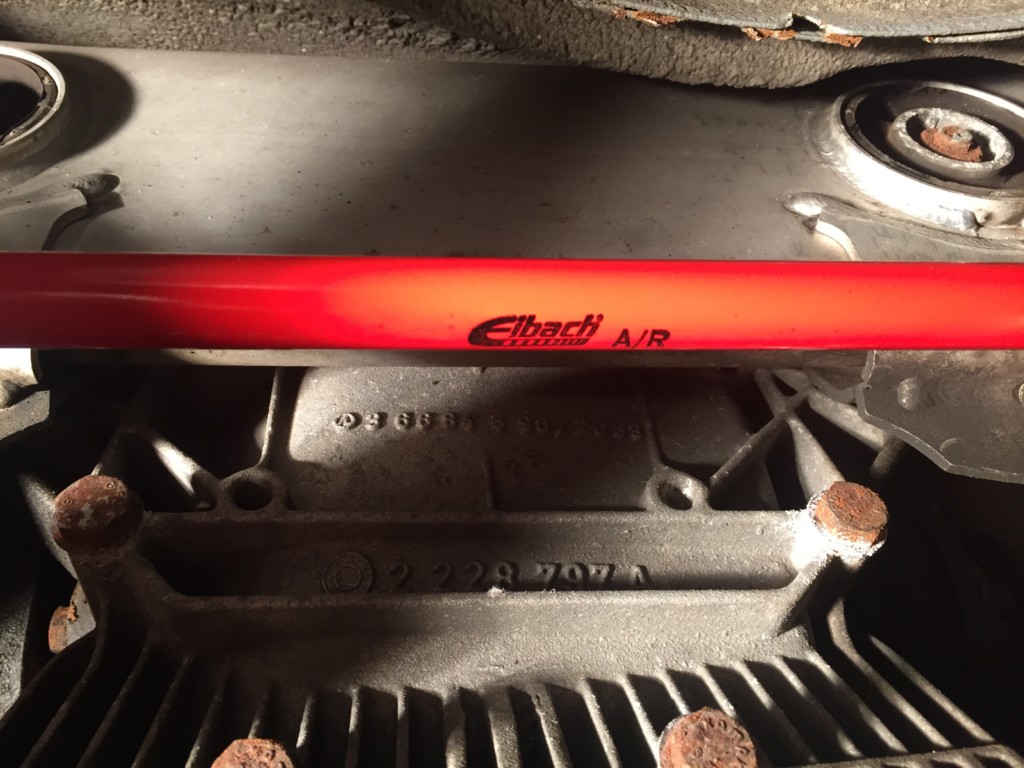
Eibach rear sway bar.
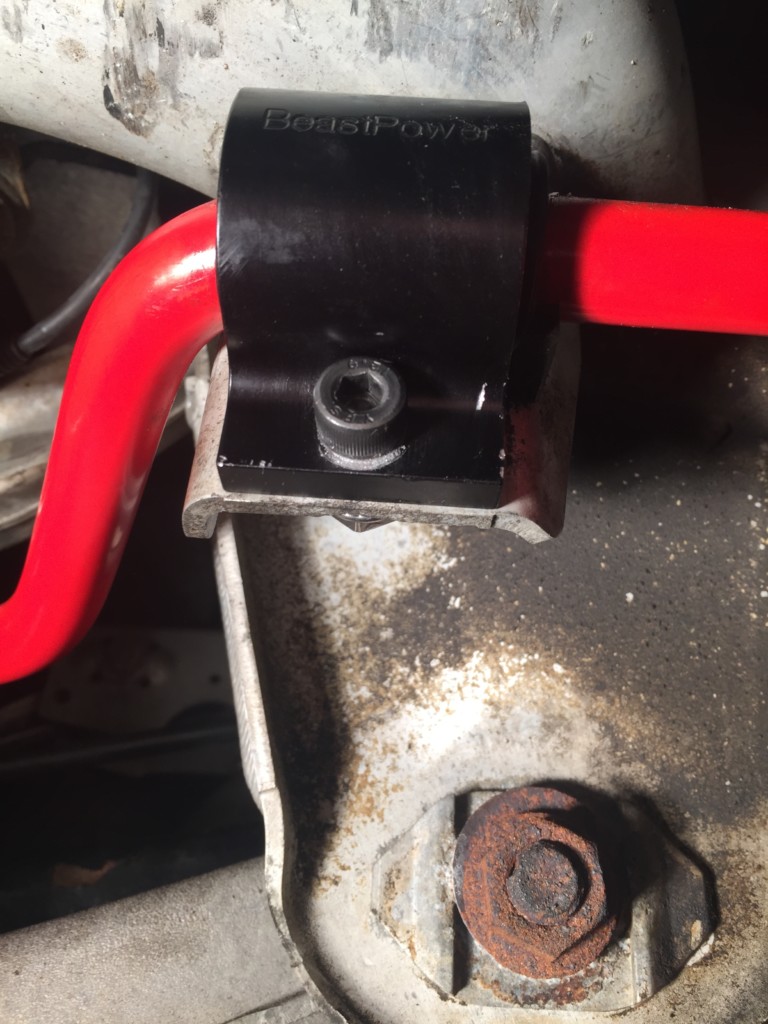
BeastPower rear sway bar brackets.
The Eibach rear sway bar is a few mm thicker than the stock bar, and makes a just-noticeable difference in the rear stability of the car. It’s fairly inexpensive and easy to fit, so I would recommend it. I also recommend using the Beast Power rear sway bar brackets over the stock BMW ones, as they will not snap off every 25,000 miles like the originals. In 2022, the Eibach bar is not currently available. Thankfully, the adjustable Dinan rear sway bar still is!
Brake Master Cylinder
This is becoming a more popular upgrade. Newer BMWs (post E39 generation) have firmer brake pedals. I noticed this in my E46 330xi, and again when I drove a customer’s E65 745Li. As it turns out, we can bring that firmer (stronger) pedal feel to our E39! The E65 7-series’ brake master cylinder is largely a plug and play upgrade on the E39’s brake booster. I purchased a new E65 master cylinder and installed it on a new E39 booster, and topped off the job with a fresh E39 brake fluid reservoir. The only additional modification here is a thread adapter from M10 to M12 for one of the pipes. After a fresh brake bleed, you’ll notice a substantially firmer pedal! Note that if you do not replace your fluid reservoir at this time, you may need to shave off some of the master cylinder’s bracket to work in conjunction with the old style reservoir.
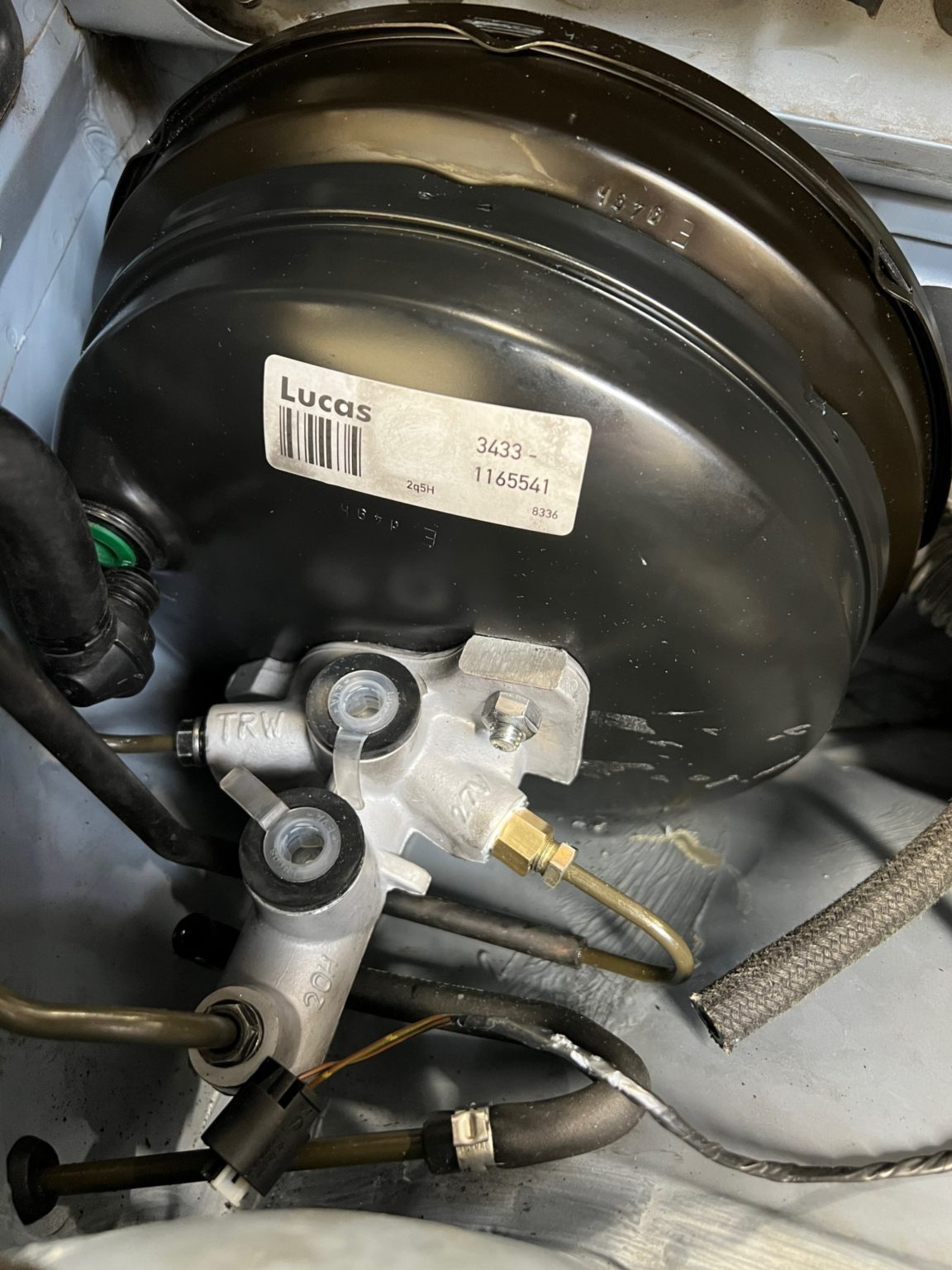
BMW E65 brake master cylinder installed on E39 M5 booster.
Brake Pads
I used to recommend the Hawk HPS pads. I used them for years and always had a great experience. They dusted less and had a better bite than the Genuine BMW Jurid/Textar pads. However, something with Hawk has changed. The last few sets I have tried (yes, I kept trying them hoping for a different result due to a bad batch) suffer from the same troubles. If it’s over 70 degrees outside, they squeak. All the time. It’s horribly annoying. And I’ve installed them correctly, put the included (and an upgraded) grease all over, to no avail. They don’t dust too much in the first few thousand miles, but after 15-20k miles, they’re dusting worse than the OEM pads and still have 90% of their material left. I can no longer recommend Hawks. I now run Carbotech 1521 street pads. These are… okay. The Hawks had better initial bite and seemed to get better and better with heat. The Carbotechs are quiet, dust very little, and do a fine job of stopping the car, but don’t have that same grip that the Hawks had.
European Brake Rotors
European market E39 M5s got different front and rear brake rotors than North American models. Why? Because we don’t have an autobahn, and thus we require less braking performance. The European rotors feature a two-piece ‘floating’ design that attaches the disk to the hub with studs instead of making it one solid piece. In addition to minimizing the weight of each rotor, cooling capacity is substantially upgraded with this two-piece design. The installation is plug and play, requiring no additional modifications. Note that the European rear rotors are now directional to allow for better cooling, where our North American rears are interchangeable.
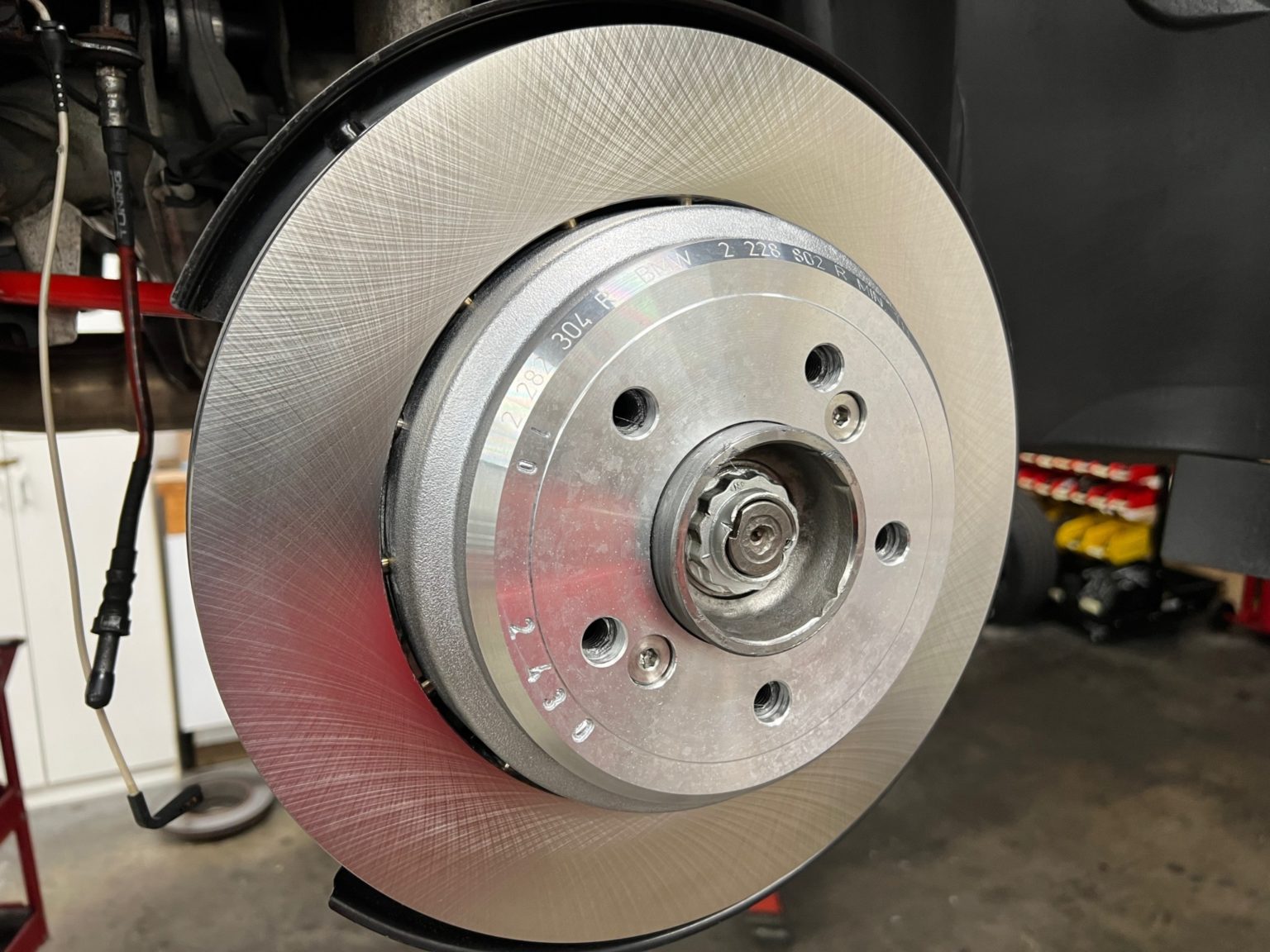
Rear European rotor installed.
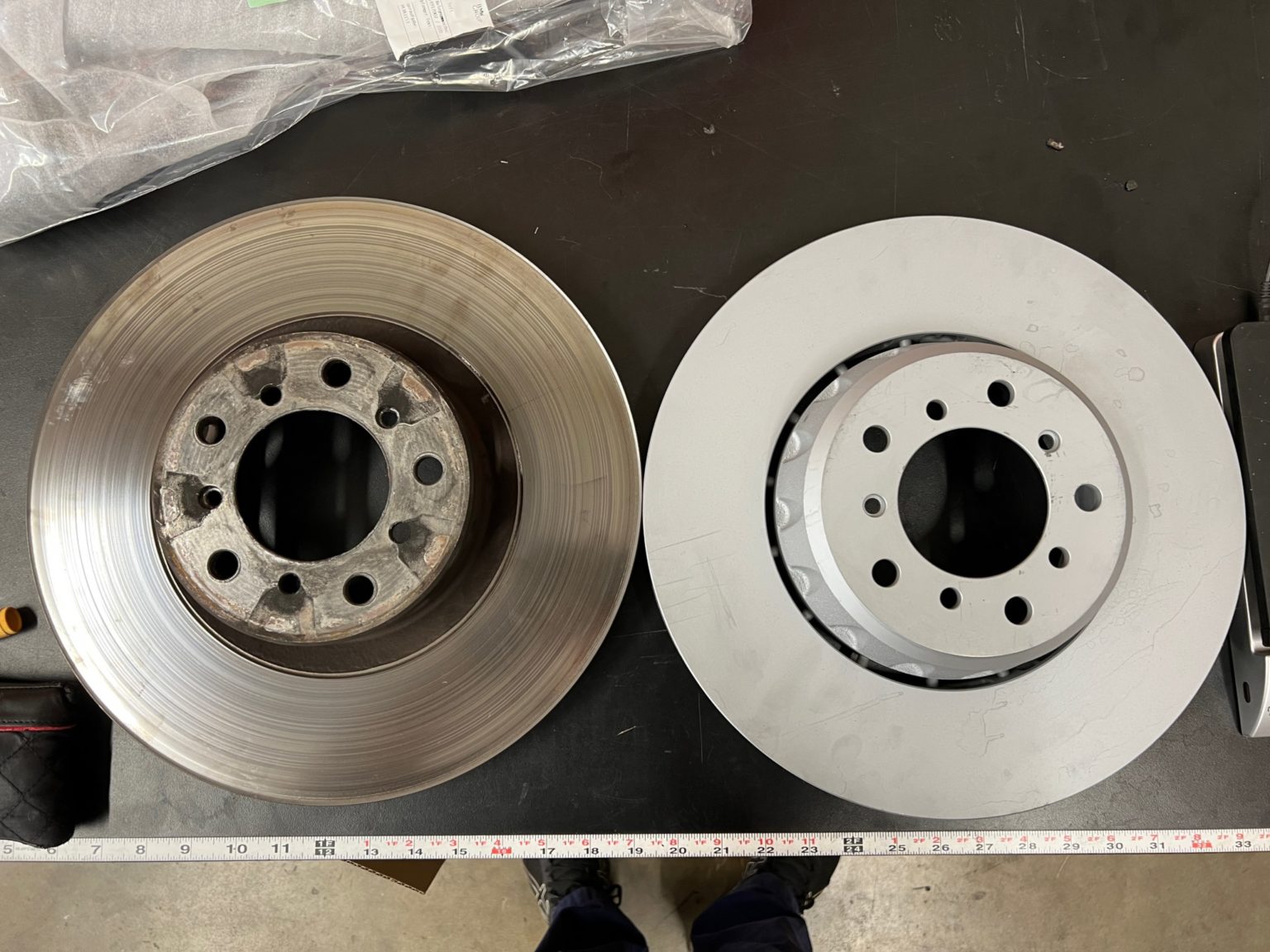
Front rotor comparison, European on right.
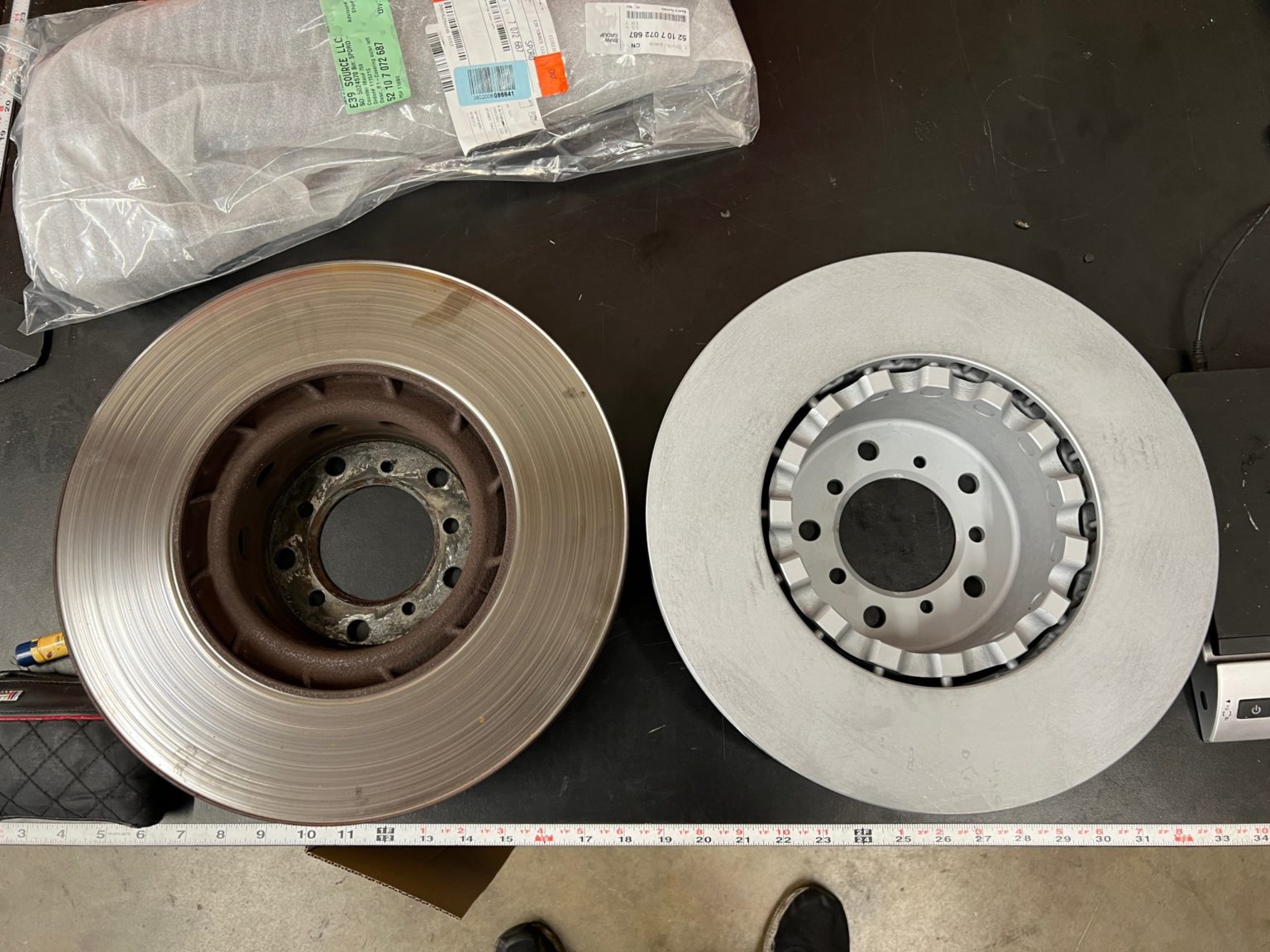
Front rotor comparison, European on right.
ECS/UUC Stainless Steel Lines
I have had two friends/clients lose their M5s to fires. Both fires were caused by the short rubber brake lines at the AND module (under the hood) rupturing and allowing brake fluid to spill all over the hot exhaust manifolds. This is not worth the risk, replace these lines with stainless steel! Several companies offer stainless steel E39 brake lines. I have the ECS ones, and I’ve been a happy customer so far. Do they make a big difference in pedal feel? No. Will they last longer than the stock rubber ones? Yes.
Square Wheel/Tire Setup
The M5 came with 18×9.5″ wheels and 275 section tires in the rear, and 18×8″ wheels with 245 tires in the front. Many owners have found that installing the wider rear wheels in the front (with spacers and longer bolts) will dial out some understeer. It is also advised to upgrade the front sway bar at this time to a thicker one. The look is pretty fantastic, it looks even more aggressive with the super wide wheels and tires upfront. The downsides are the cost of both the bigger wheels and tires, but also the cleanliness of the car. I have avoided this mod personally because the wider setup does coat the side of the vehicle with road dust and grime, whereas the standard setup does not. If I tracked my car or frequently drove it very hard, I would very likely change my tune.
The Usual Suspects
By this point, you’re probably curious as to why I have not mentioned the usual E39 M5 mods: Supercharging, and headers. This is because the E39 M5, to me, is not a race car. It was never designed to be a race car, and I have no desire to turn it into one. Lightweight wheels, more power, and crazy loud exhaust setups just don’t fit the car. Neither do crazy lowering springs or limo tint. If 400 horsepower is not enough power, perhaps a different car should be in your garage. Having said that, a set of headers can add quite a bit of power. They also change the sound of the car. For some, this is for the better, but to others, not so much. Many owners try the South Bend clutch; but I have yet to hear one person say that they actually like it. The same goes for CAIs (cold-air intakes). Few understand that the E39 M5 actually came with a cold air intake from the factory… so these aftermarket kits are for visual appeal only. I do recommend the K&N engine filters in the stock boxes, but not any aftermarket intakes.
I have watched many E39 owners turn their cars into something totally impractical, and sometimes, downright unusable. They can’t clear even the subtlest of speed bumps. They can’t talk in the car due to the exhaust noise. They can’t drive the car more than 1 hour because it’s too uncomfortable. Nobody can ride in the rear seat because the tires will rub the fenders. Their transmissions and clutches make horrible rattling noises. Their big brake kits squeal and squeal and squeal away. Their huge wheels rub the fenders. The list goes on and on. I cannot recommend any of those modifications.
